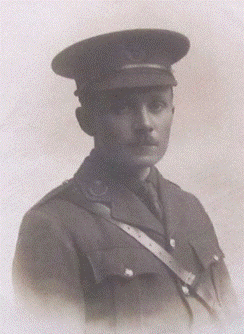Fact file:
Matriculated: 1900
Born: 28 May 1881
Died: 12 May 1915
Regiment: Durham Light Infantry
Grave/Memorial: Bedford House Cemetery (Enclosure 2): VI.A.47
Family background
b. 28 May 1881 at 3, Oak Villas, Bromley Rd, Beckenham, Kent, as the eldest of six children (four sons) of Arthur Walker Cree, BA MA (1852–1930) and Elizabeth Cree (née Newby) (1852–1928) (m. 1879). At the time of the 1881 Census the family was still living at 3, Oakhill Villas, but by the time of the 1891 Census it had moved to “Brodsworth”, 124, Bromley Rd, Beckenham, Kent (three servants); it was still living there at the time of the 1901 and 1911 Censuses (six servants). The family later moved to Thorn Cottage, Berkhamstead, Hertfordshire, possibly while three of the sons were training nearby with the Inns of Court Officers’ Training Corps.
Parents and antecedents
Cree’s father was a solicitor who had studied at Exeter College, Oxford, from 1871 to 1874 and whose practice, Cree & Son, was at 13, Gray’s Inn Square, London. Cree’s grandfather, Thomas Cree, had been called to the Bar at Gray’s Inn and “Brodsworth”, the Crees’ house in Beckenham, was named after the Yorkshire birthplace of both men.
The broader Cree family included several clergymen and military men, and one of Cree’s uncles was the Revd John Adams Cree (1824–1904), who studied Classics and Mathematics at University College, Oxford, from 1843 to 1847 (MA 1849). He was ordained deacon in 1848 and priest in 1849, and served as the Curate of St Leonard’s Church, Streatham, from 1848 to 1852. From 1852 to 1858 he was the Curate of St Mary the Virgin, Dover, and, simultaneously, a Fellow of Magdalen (BD 1856). But he resigned his Fellowship in 1859 in order to get married and spent the rest of his life as a parish priest in well-endowed livings in Buckinghamshire, leaving over £30,000 in his will.
Cree’s mother was the daughter of William Crawford Newby (1808-1884) and his wife and cousin Frances Newby (1828-1884) . Newby was an attorney and Notary Public in Stockton upon Tees and in his obituary is described as being ‘prominent among the rapidly thinning band of “Old Stocktonians” who belonged to the pre-industrial days when Stockton was only a flourishing market town.” “Although not a public man was one of the best known and most widely respected citizens of Stockton.”
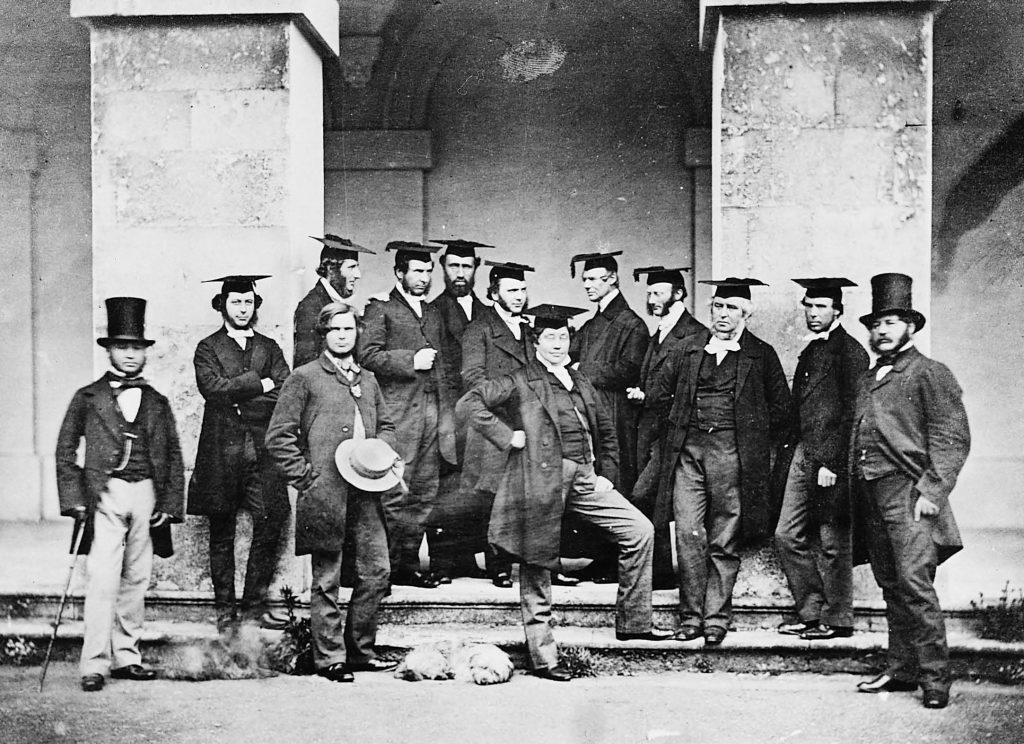
Magdalen’s Fellows standing outside the New Buildings (1858); the Revd John Adams Cree (Fellow 1852–58), is standing second from the right at the back (Photo © Magdalen College, Oxford; courtesy of Magdalen College, Oxford)
Siblings and their families
Brother of:
(1) John Francis George [later BA] (1882–1949) (m. [1909 (Guernsey)] Agatha Blanche Carey [1883–1974]), one daughter;
(2) David [later Colonel RE, MC] (1883–1945);
(3) Charles Edward Victor Cree (1887–1916, killed in action 20 July 1916 at Bellacourt, on the Somme, when serving as a Captain with the 1/6th Battalion [Territorial Forces], the Sherwood Foresters [the Nottinghamshire and Derbyshire Regiment]);
(4) Elizabeth Katherine [“Betty”] (1889–1961) (later Shelley after her marriage [1915] to Guy Birkbeck Shelley [1889 (Sydney)–1976 (Antibes)]);
(5) Georgina [“Ina”] Mary (1897–1978) (later Hughes after her marriage [1920] to Philip Hughes [1883–1981]).
John Francis George studied Law at Magdalen from 1901 to 1904 and then became part of his father’s firm of solicitors. He must have known the somewhat younger C.H. Davies since the two men were serving in the same Battalion at the time of Davies’s death. At the time of the 1911 Census, he and his family were living at 64, Park Rd, Dulwich; at the time of his death he and his family were living at 9, Beulah Hill, Upper Norwood, Surrey, and he left them £21,323 3s 6d. John Francis George is mentioned in his Battalion’s War Diary on 11 January 1916 and was wounded on 1 July 1916.
John Francis George’s wife Agatha Blanche was the daughter of a medical practitioner, Arthur Edward Carey (1840–95), and his second wife Blanche Amelia Carey (née Bell) (1855–1938) (m. c.1890 [Ceylon]). Arthur Edward Carey attended Trinity College, Cambridge, then became a coffee planter in Ceylon, and finally studied Medicine at St Mary’s Hospital, Paddington, London. At the time of the 1881 Census, he and his family were living at 33, Powis Square, Kensington, London SW, and at the time of the 1891 Census they were living at 1, The Crescent, Bedford. They were still living here at the time of Arthur Edward’s death.
David attended Wellington College from 1898 to 1901 and then the Royal Military College (Sandhurst), after which he was commissioned in the Royal Engineers. During World War One, he served in the Royal Engineers with the South Africans in German East Africa. He was awarded the MC and rose to the rank of Colonel.
Guy Birkbeck Shelley was a prosperous Australian shoe manufacturer.
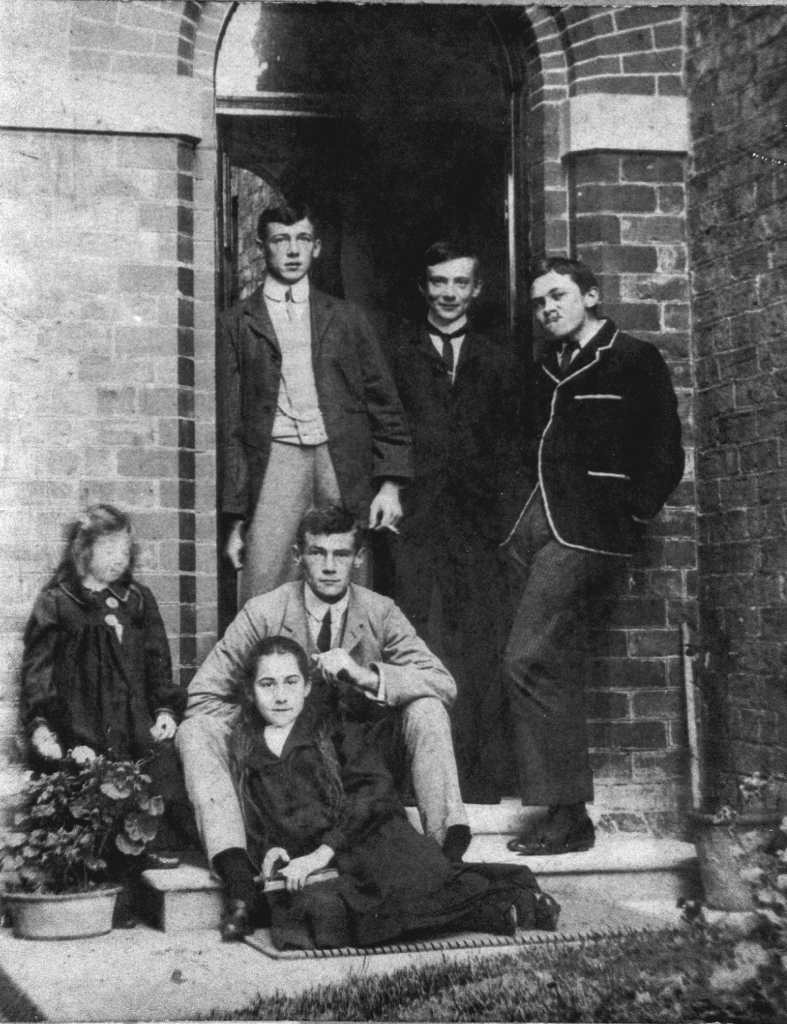
The Cree children in the porch of 124, Bromley Rd, Beckenam, Kent: standing (from left to right): John Francis George; Charles Edward Victor; Arthur Thomas Crawford; sitting (from left to right): Georgina, David, Elizabeth Katherine.
(Photo © Sir Robin Knox-Johnston; courtesy of Sir Robin Knox-Johnston)
Wife and children
Cree’s wife was Ivy Elizabeth Marrion Cree (née Williams) (1883–1981) (m. 1907), the only daughter of Captain George Stanley Williams of Queniborough, Leicestershire. By the time of the 1911 Census the couple were living at 13, Albert Bridge Rd, Battersea, London SW; they then moved to 23, Overstrand Mansions, Prince of Wales Rd, near Battersea Park, London SW. From 1915, their address was “Avalon”, Bois Avenue, Chesham Bois, Buckinghamshire. By the end of July 1915, Ivy Elizabeth was living at “Anthony’s”, The Green, Chesham Bois, Buckinghamshire.
Cree was the father of:
(1) Elizabeth Mary (1908–2004) (later Johnston after her marriage [1937] to David Robert Knox Johnston [1910–70]), four children;
(2) Janet Katherine (1910–92) (later Platt-Mills after her marriage [1936] to John Faithful Fortescue Platt-Mills, QC [1906 Wellington (NZ)–2001]), six sons;
(3) Eleanor (1912–2008) (later Irving after her marriage [c.1936] to Charles Arthur Le Mesurier Irving [later OBE] [1903 (Hong Kong)–1986]), two sons, two daughters.
David Robert Knox Johnston came from a family of linen manufacturers, served in Greece with the Royal Engineers during World War Two, and in the 1950s was a Beckenham Borough Councillor. Their oldest son was (Sir) Robin Knox Johnston (b.1939), who accomplished the first solo non-stop circumnavigation of the globe.
Janet Katherine was a talented painter and studied from 1928 to 1933 at the Byam Shaw School of Art (70, Campden St, London W8), founded in 1910 by John Liston Byam Shaw (1872–1919) and Rex Vicat Cole (1870–1940): it was absorbed in 2003 by Central St Martin’s College of Art and Design. It’s first Principal (1926–40) was Ernest Jackson (1872–1945), who is best remembered for designing the map of the London Underground. In her final year at the School, when she was only 23, Janet became the first art student to have a painting included in the Royal Academy’s summer show, and in the same year the Tate Gallery acquired one of her works. She gave up art in the late 1930s in order to bring up her family, but resumed work in 1967.
John Faithful Fortescue Platt-Mills, QC (1906–2001) was a British Labour Party politician who was born in Wellington, New Zealand, to that country’s first woman doctor, who was a campaigner for women’s education and men’s abstinence from drink. After a glittering university career in both New Zealand and Britain, he was called to the bar in the Middle Temple in 1932 and rapidly built up a common law practice and a busy social life. His political sympathies were initially right-wing, but he moved to the left because of the Hoare–Laval pact of December 1935, when Samuel Hoare (1880–1959), the British Foreign Secretary, and Pierre Laval (1883–1945), the French Prime Minister, tried to temporize secretly with Mussolini over Abyssinia, and he joined the Labour Party in 1936. During World War Two, he held a commission in the Royal Air Force for a few months in 1939, but was forced to resign, probably by the Security Services, and returned to the Bar. Churchill then put him in charge of making propaganda on behalf of Soviet Russia, Britain’s new ally, and he was responsible for organizing the Soviet Friendship Committees that grew up all over Britain. During the closing stages of the war he voluntarily worked down the mines as a “Bevin Boy” in Yorkshire for 18 months and gained a great and lasting respect for the skill and courage of miners. In the 1948 election, he won the apparently safe Conservative seat of Finsbury but became deeply unpopular with the Labour leadership because he joined almost all the organizations that were on Labour’s proscribed list, opposed NATO, and was openly pro-Soviet Russia. After organizing the so-called Nenni Telegram, a message of support to Pietro Nenni (1891–1980), the leader of the Italian Socialist Party that was fighting an election in 1948 in co-operation with the Italian Communists, and then refusing to recant, Platt-Mills was ejected from the Labour Party and fought the General Election of 1950 as an Independent Labour MP – unsuccessfully as it turned out. He became even more unpopular after attending Stalin’s funeral in 1953 and had difficulty making ends meet as a barrister. He was finally made a QC by a Conservative Lord Chancellor in 1964 and made his name by means of criminal defence work. In 1969 he was re-admitted to the Labour Party, but continued to position himself on the far left. In 2001, when he was in his nineties, he represented three families at the Bloody Sunday enquiry.
Charles Arthur Le Mesurier Irving was the son of a colonial administrator in Penang and later became an economist in the Ministry of Agriculture and Fisheries in Britain.
Education and professional life
Cree attended the Abbey and Merton House Schools, Beckenham, Kent [from 1896 Clare House Preparatory School, Beckenham; now defunct], from 1889 to 1895 [cf. C.E.V. Cree] and Shrewsbury School from 1895 to 1900, where his two younger brothers would also be educated. Here he became a Praepostor and, according to President Warren:
imbibed a sound taste for classical scholarship, which he loved for its own sake, and not merely with a view to honours in the Schools. In particular he was much interested in Aristophanes, which he had learned to love from Mr. B[enjamin] Bickley Rogers [1829–1919, a free-lance English classicist who translated all of Aristophanes’ plays] himself.
He matriculated at Magdalen as a Commoner on 15 October 1900, having taken Responsions in Hilary Term 1900. He took the First Public Examination in Trinity Term 1901 and Hilary Term 1902, and in the latter term he was awarded a 3rd in Classical Moderations. In Trinity Term 1904 he was awarded a 2nd in Literae Humaniores and he took his BA on 20 October 1904. He was admitted to the Inner Temple on 13 May 1902, while he was still an undergraduate at Magdalen, and on 5 July 1905 he was called to the Bar “where he was making his way very well”, first on the North-Eastern Circuit, then on Chancery matters.
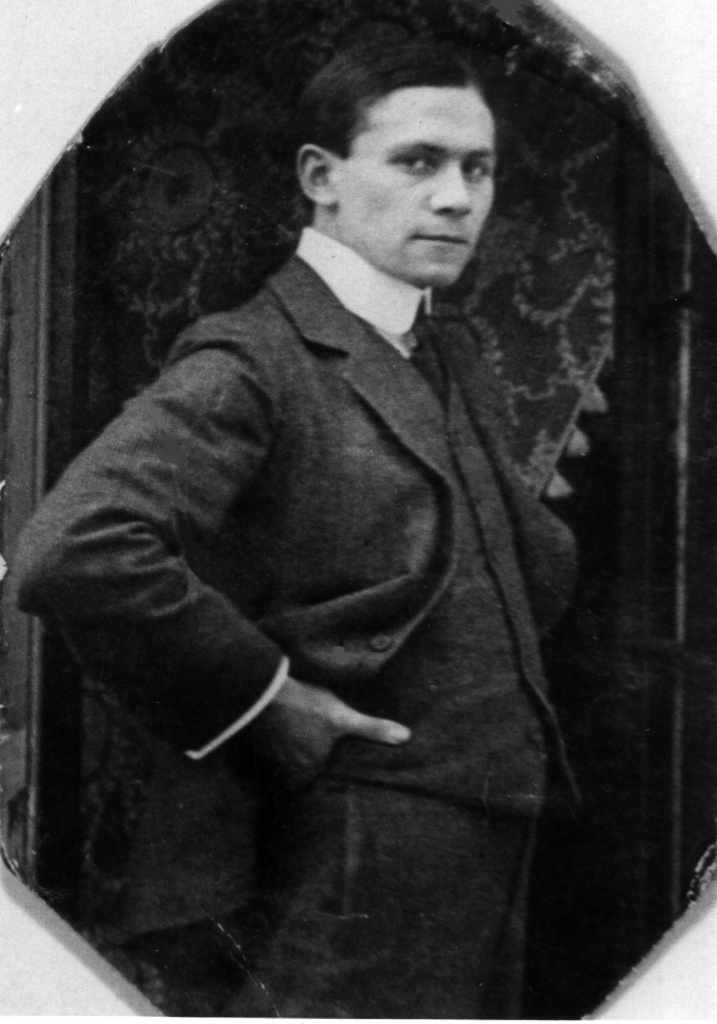
Arthur Thomas Crawford Cree, BA
(Photo© Sir Robin Knox-Johnston; courtesy of Sir Robin Knox-Johnston)
Cree had an interest in social questions and from 1 November 1909 to 1912 represented Park Road Ward on Battersea Borough Council as a member of the Municipal Reform Party (MRP). The MRP was the local version of the Parliamentary Conservative Party and was founded in 1906 to oppose the growing power of the Progressive and Labour Parties in London’s municipal government. Its major policies were the reduction of rates, tight controls on and proper auditing of public expenditure, a coordinated transport policy, the provision of electricity by private enterprise, and an educational policy that favoured denominational schools. In 1906 it gained control of 22 out of London’s 28 borough councils and in 1909 it again won a landslide victory in Battersea. Its power began to wane in 1919 and it was superseded by the Conservative Party in 1945. During his three years as a Councillor, Cree served on the Law and Parliamentary Committee, the Distress Committee, and the Law and General Purposes Committee; he was one of the Council’s representative Managers of Battersea Park Road School, Latchmere School and Shillington St School; and in February 1912 he became the Council’s representative on the Old Age Pensions Sub-committee for Battersea and Wandsworth. Warren described him as “a shrewd, sensible, kindly fellow, the best type of an English professional gentleman”.
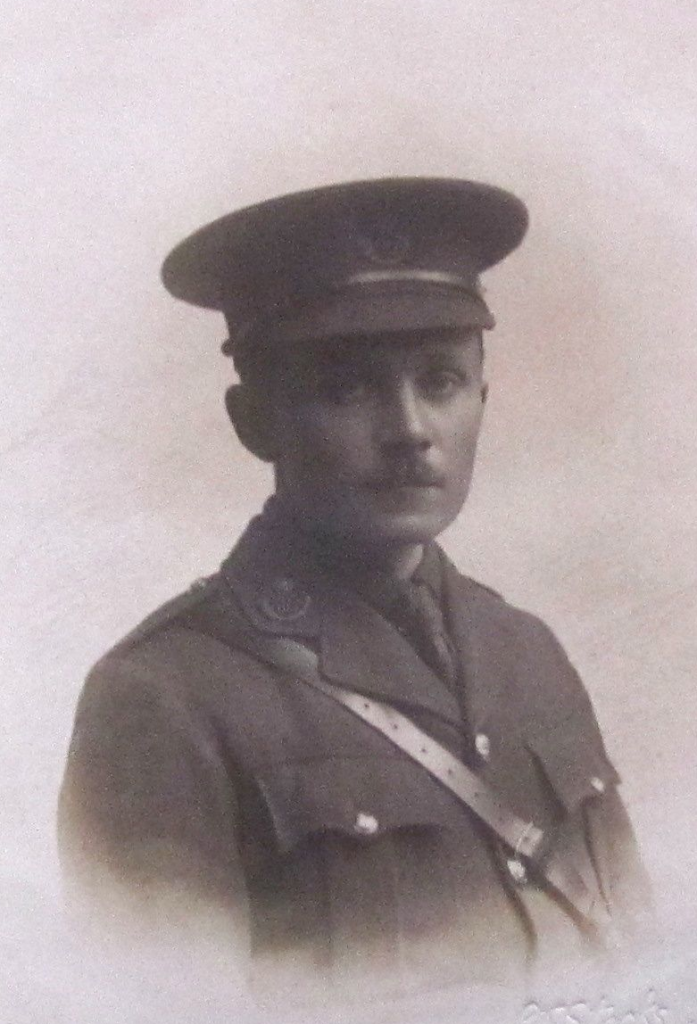
Arthur Thomas Crawford Cree, BA
(Photo courtesy of Magdalen College, Oxford)
“A shrewd, sensible, kindly fellow, the best type of an English professional gentleman.”
Military and war service
Cree was 5 foot 9½ inches tall, and while at Oxford he was a member of the Oxford University Volunteer Rifle Corps until 1903. He attested and joined the Inns of Court Officers’ Training Corps (“The Devil’s Own”) as a Private on 5 August 1914, and was promoted Lance-Corporal on 29 September 1914, when the unit, including Rowena, its one cavalry mount, was in camp training on a sloping field near the railway station in Berkhamsted, Hertfordshire. The training involved two field days per week and besides learning about weapons, tactics and trench-building, the cadets were toughened up by extensive physical training and route marching, since they were expected as officers to have reached a higher level of fitness than that of their men. Cree was soon joined by his two brothers – John Francis George joined his brother’s Company on 23 September and Charles Edward Victor joined the newly formed ‘D’ Company on 29 September. On 26 October 1914 Cree applied for a Territorial Forces commission; on 26 November 1914 he was discharged from the Officers’ Training Corps; and on 27 November 1914 he was commissioned Lieutenant in the 1/7th (Territorial Forces) Battalion, the Durham Light Infantry, 151st Infantry Brigade, 50th (Northumbrian) Division. The Battalion, which had been formed in Gateshead, arrived in Boulogne on 19 April 1915 and reached Verlorenhoek on 25 April. From 28 April to 1 May the Battalion supported front-line troops north of Frezenberg, about three miles east-north-east of Ypres, by digging and performing other fatigues, and then withdrew eight miles westwards to the woods at Brandhoek, just to the west of Vlamertinghe.
Cree disembarked in France on 5 May, joined his Battalion on 9 May 1915, when it was still in those woods, and was promoted Temporary Captain two days later. The Battalion, many of whom had been miners, left Brandhoek at 07.30 hours and marched by a circuitous route to Zillebeke, some eight miles due east, where it rested before spending five-and-a-half hours during the night digging trenches under the supervision of a Royal Engineers officer before being relieved at about 02.30 hours and retiring about two miles to the so-called General Headquarters line (the second line of trenches east of Ypres). Here, on 12 May 1915, the Battalion was heavily shelled and lost 14 men and an (unnamed) officer, who must have been Cree, aged 33.
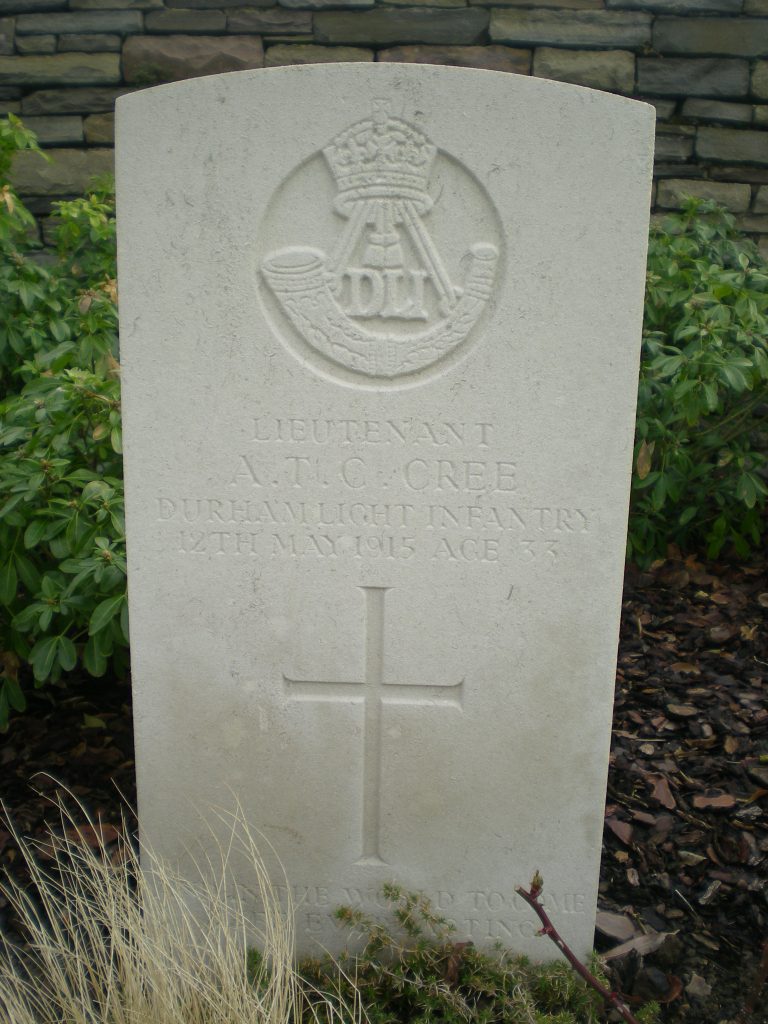
Bedford House Cemetery (south of Ypres), Enclosure 2; Grave 6.A.47
After his death, Cree’s Commanding Officer, Lieutenant-Colonel Vaux, wrote a letter to Cree’s wife in which he described her husband’s last hours:
We had been digging all night. Your husband had been left behind with a party of men to bring up some more tools. I went back and stopped him coming any further at about 1.30 a.m. and then sent them all into some dugouts where I slept myself. Next morning I had some talk with him, he being the only officer present, & left him to visit the lines. I came back about ½ hour later & found him wounded. I had some talk with him, never thinking he was badly hit, & went myself with him to The Hospital about 1 mile back. I saw The Doctor was rather frightened about him & could not find any wound, but his hand that was badly hit. I chaffed him he would soon be home again. He complained of a pain in his stomach. I thought he might have had a blow – I went back later on in the day & found he had passed away soon after I had left. I went back with a party at night & myself saw him buried as Company Officers have to go out digging. I also got a very nice cross made and carved his name on.
Somewhat inappropriately, given the circumstances of his death, Cree’s Shrewsbury obituarist described the cross as “crowned with the glitter of steel and the glimmer of tears”. Cree’s body was first buried to the right of the school on the Menin Rd (east of Ypres) and subsequently transferred to Bedford House Cemetery (south of Ypres), Enclosure 2; Grave 6.A.47 next to Privates A. Sharp and N.R. Sterling of the same Battalion, who were killed in action on 14 May and 15 May respectively; the inscription was: “And in the world to come life everlasting” (Luke 18:30). He is commemorated on Shrewsbury School War Memorial and by a wooden grave marker in St Barnabas’ Church, Beckenham. At the time of his death, Cree had been earning £54 15s p.a. in the Army. His widow, Ivy Elizabeth, received a gratuity of £140 and a pension of £100 p.a., and each of their three children received a gratuity of £46 13s 4d together with a “compassionate allowance” of £24 p.a.
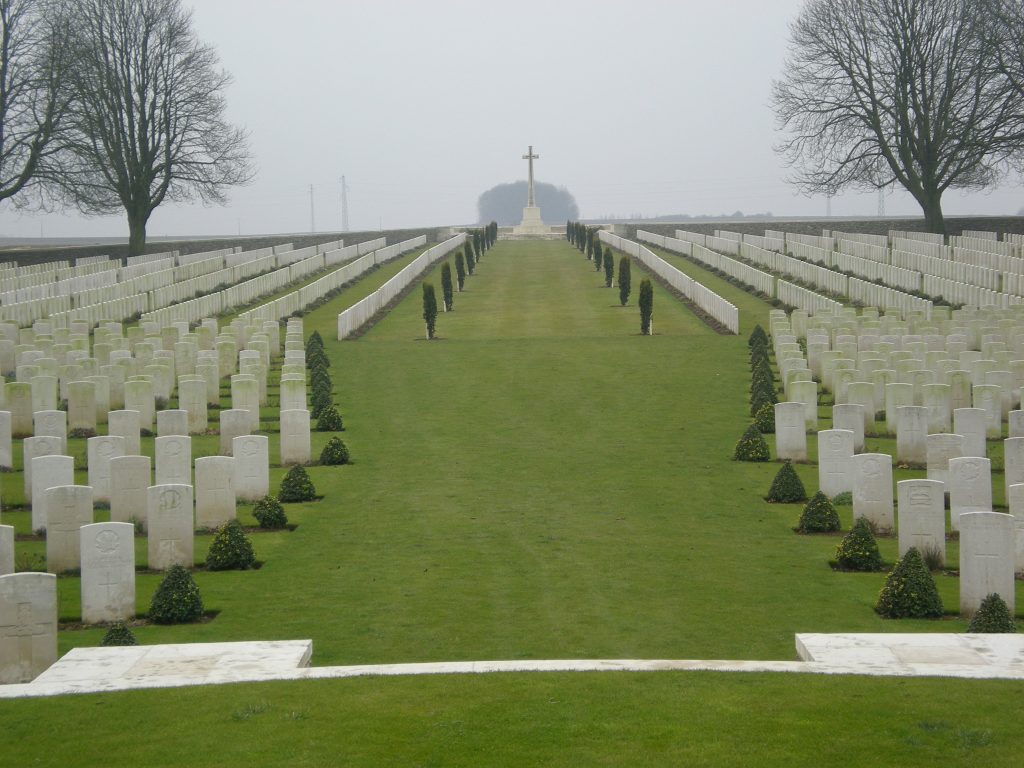
Bedford House Cemetery is just over a mile south of the centre of Ypres, on the N336 which runs southwards from Ypres to Armentières. Designed by the British architect Wilfred Clement Von Berg (1894–1978), it originally consisted of five cemeteries of different sizes and now contains the remains of 5,139 Commonwealth servicemen.
Bibliography
For the books and archives referred to here in short form, refer to the Slow Dusk Bibliography and Archival Sources.
Special acknowledgements:
*Gwyneth Wilkie, ‘Arthur Thomas Crawford Cree (1881–1915)’, in Chiltern U3A Family History Groups (ed.), Amersham Remembers the Men who Gave their Lives in the Great War (Amersham: Chiltern U3A, 2015), pp. 127–31, 80 copies. Also as
http://amershamhistory.info/research/wwi/amersham-remembers/
Printed sources:
Printer’s Pie (1904), pp. 348 and 391.
[Anon.], Death of Mr W.C.Newby, Hartlepool Northern Daily Mail. no. 1776 (7 January 1884), p.4.
[Anon.], ‘Lieutenant Arthur Thomas Cree’ [obituary], The Times, no. 40,861 (22 May 1915), p. 6.
[Thomas Herbert Warren], ‘Oxford’s Sacrifice’ [obituary], The Oxford Magazine, 33, no. 24 (28 May 1915), p. 335.
[Anon.], ‘Obituary: Lieut. Arthur Thomas Crawford Cree’, The Salopian, 23, no. 13, issue 294 (29 May 1915), p. 220.
Errington (1922), p. 134.
Leinster-Mackay (1984), pp. 134, 327.
Lena Jaeger, ‘John Platt-Mills’ [obituary], The Guardian, no. 48,452 (27 October 2001), p. 22.
Archival sources:
MCA: Ms. 871 (III), vol. 1.
OUA: UR 2/1/41.
WO95/2840.
WO374/16496.
